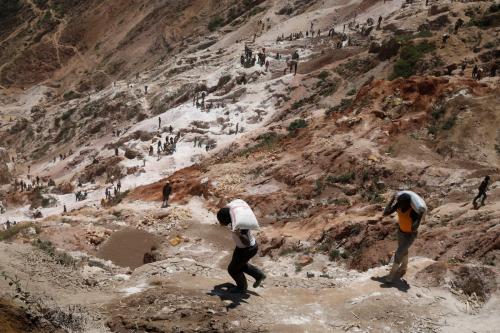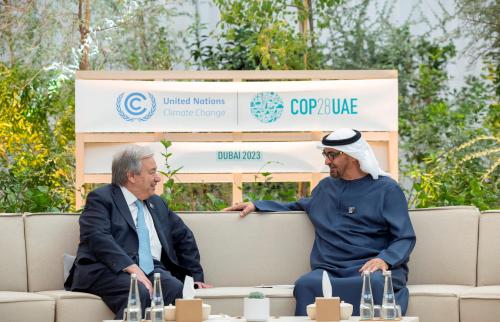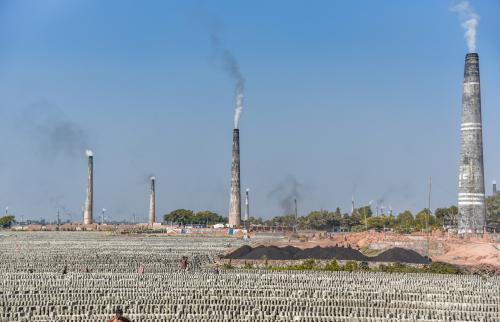Governments have a responsibility to protect people within their territory from harm, including such diverse threats as terrorists to deadly diseases. This responsibility also means protecting them from disasters and environmental change, including the effects of climate change. Governments do this in a range of ways. For example, they assess the risk of disasters, take measures to reduce the negative impact of environmental changes, or plan for the effects of climate change. Sometimes they also have to move people from where they are living in order to keep them safe.
One of the consequences of disasters and environmental change is that some areas become too dangerous for people to continue living there and they must move or be assisted to move somewhere else. These relocations are already taking place, but the need to move people is likely to become more widespread as the effects of climate change continue to manifest. Together with the UN High Commissioner for Refugees (UNHCR) and Georgetown University, we have been working over the past few years to look at the future use of planned relocations – and in particular, how they might be carried out in a way that upholds the rights and dignity of those who are being moved.
Clear lessons from past efforts: careful planning is needed before people are moved, relocations should be a last resort, and affected people must be supported to rebuild their lives in the new locations.
The issue of relocations is a complicated one because no one wants to be forced to leave their homes. On the one hand, some think it’s too early to be thinking about relocating people from their communities when there’s still a chance that the powers that be will come to their senses (like at the upcoming COP21 meeting in Paris) and reduce carbon emissions to prevent the global warming which is wreaking havoc with the world’s habitats. On the other hand, the experiences of relocating people to make way for major infrastructure projects have been overwhelmingly negative as too often people are left impoverished and forgotten. Clear lessons from relocation efforts in other contexts are that careful planning is needed before people are moved, that relocations should be a last resort, and that affected people must be supported to rebuild their lives in the new locations. The fact is that relocations are already occurring and as I have argued earlier, the time to start thinking about planned relocations is now.
Following last year’s successful meeting on relocations in Sanremo where the issue of planned relocations was discussed in great depth, we realized that further evidence was needed. We needed more research about what had already been done before we could work toward the next step – developing guidance for governments and others as they begin thinking or carrying out planned relocations to protect people from disasters and environmental change, including the effects of climate change. So, with the support of the MacArthur Foundation, we commissioned background studies on planned relocations that have already taken place (or are currently underway) including Sri Lanka after the 2004 tsunami, the 2010-11 Canterbury earthquakes in New Zealand, post-Typhoon Haiyan in the Philippines, and in Vietnam where the government has long seen planned relocations as part of its disaster risk reduction/climate change adaptation strategy. We put together an annotated bibliography of reported cases of planned relocations in different situations and different parts of the world. (Surprisingly no studies of Europe turned up in this literature review). In preparation for drafting guidance for governments and other actors who might be involved in planning and carrying out relocations in the future, we looked at 30 different operational frameworks that seemed relevant, from the World Bank’s Operational Guidelines on Involuntary Resettlement to the Guiding Principles on Internal Displacement to the UNHCR/UN Habitat Fact Sheet on Forced Evictions. We pulled out 25 common issues which seemed to run through existing frameworks. These common issues included such general principles as the need to engage those to be relocated in the planning process and the need to ensure adequate funding before beginning to move people.
The issue of planned relocations is a cross-cutting area where expertise is needed in a range of different fields, including: climate change, development, disaster risk reduction, environmental law, human rights, humanitarian response, and migration. However, we also learned that experts coming from different fields bring not only diverse conceptual approaches but also different understandings of basic words; for example, the word ‘resettlement’ means very different things to those working with refugees and those who are involved in moving people because of the construction of a dam. In fact, last year’s meeting in Sanremo was not able to reach consensus on what the term ‘planned relocation’ meant and spent a lot of time talking about definitions. To avoid endless discussions of definitions, we organized a preparatory meeting in Washington with experts from each of the seven fields mentioned above to come to an agreement on a definition of planned relocation.
Finally we gathered together a group of 19 experts at the stunningly beautiful Rockefeller Center in Bellagio, Italy for three days in May 2015 to put together draft guidance on planned relocations. The participants worked hard on the text, sometimes spending hours on a single phrase (who decides when a community must be moved? on the basis of what evidence? what does it mean to consult with persons and is that the same as their participation in the process? what about the rights of those in the host communities and those who choose not to participate in planned relocation?) We were successful in coming up with guidance, but it remains a draft which needs validation in far broader circles than we were able to bring together in Bellagio. Together with our partners, we are now beginning a year-long process of wide consultation, soliciting comments, and feedback from a range of governments, communities, and an even broader circle of experts. We hope that this guidance will be discussed in different arenas – from meetings on climate change and on migration to the UN Human Rights Council, to the World Bank to regional organizations like at ASEAN and CEPREDENAC.
I hope that the overarching principles in this guidance will be incorporated into national laws, policies, and strategies. At the same time we’ll be working with UNHCR and Georgetown University during the coming year to develop operational guidelines to translate this general guidance into concrete suggestions for how planned relocations should work in practice.
The issue of using planned relocation in order to protect people is uncharted territory. We are eager to hear about other experiences in planned relocations and to receiving your feedback on what kinds of operational guidance are needed. Help us get it right: email ideas to [email protected].



Commentary
When protecting people from natural disasters and environmental change means relocating them
June 12, 2015